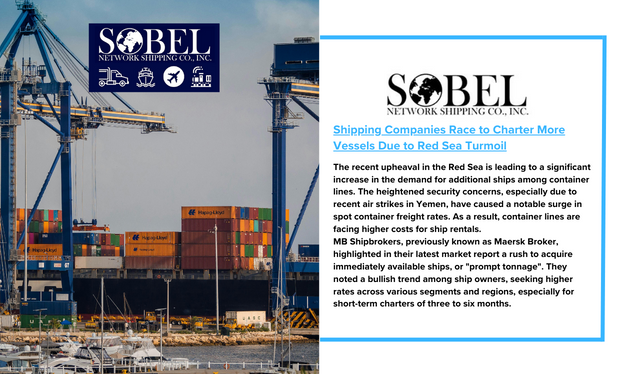The recent upheaval in the Red Sea is leading to a significant increase in the demand for additional ships among container lines. The heightened security concerns, especially due to recent air strikes in Yemen, have caused a notable surge in spot container freight rates. As a result, container lines are facing higher costs for ship rentals.
MB Shipbrokers, previously known as Maersk Broker, highlighted in their latest market report a rush to acquire immediately available ships, or “prompt tonnage”. They noted a bullish trend among ship owners, seeking higher rates across various segments and regions, especially for short-term charters of three to six months.
Braemar Shipbrokers also observed a similar trend, with increased chartering activity and growing interest in various prompt vessels of all sizes across different regions. They report a firming trend in both charter rates and periods.
Alphaliner, an analytics group, echoed these observations in a recent report, pointing out the emerging impact of the Red Sea situation. They note that despite the influx of new ships, the demand for charter-market vessels remains robust, partially fueled by the ongoing Red Sea crisis.
The diversions from the Red Sea, which have led to delays in return voyages to Asia, have compelled liner companies to charter additional ships for short periods to manage the increased workload. With these diversions becoming more entrenched, liners are now looking to add more vessels to their fleets to maintain regular schedules, given the extended journey around the Cape of Good Hope.
In cases where newbuildings and existing fleets fall short, liners may have to resort to chartering or purchasing additional ships. The Harpex index, which tracks charter rates for ships up to 8,500 twenty-foot equivalent units, has seen a 12% rise since mid-December. This increase is modest compared to the dramatic surge in spot freight rates, which have more than doubled in the same period according to Freightos and Drewry indices.
The Red Sea crisis has unexpectedly boosted the Harpex index by 28% compared to its January 2019 level, pre-COVID. Alphaliner suggests that the ongoing issues in the Red Sea and the Panama Canal might mitigate the risks of overcapacity due to the increased demand for extra tonnage.
The current charter market, however, faces a scarcity of available ships for leasing. Most vessels are already tied up in long-term contracts. During the supply chain crisis, liners scrambled to control more ships to capitalize on high freight rates, leading to lucrative profits.
Non-operating owners (NOOs), who charter ships to liners, were in a position to demand high rates and long-term commitments during the peak of the COVID-era boom. Many of these leases are still in effect, with companies like Danaos, Costamare, Global Ship Lease, and Euroseas having a significant portion of their fleets locked in charters for 2024.
The limited availability of ships for immediate chartering is keeping activity subdued, as reported by MB Shipbrokers. Moreover, some relet opportunities, where liners sub-charter ships from NOOs, are being withdrawn.
In the stock market, liner companies are expected to benefit more from the Red Sea disruptions than NOOs, given the sharper rise in freight rates compared to charter rates. Data from Koyfin, accounting for dividends, shows a significant increase in the stock prices of liner operators like Zim, Hapag-Lloyd, and Maersk since mid-December, outperforming NOO stocks. Notably, Euroseas, with greater exposure to the 2024 charter market, has seen the most substantial rise.


